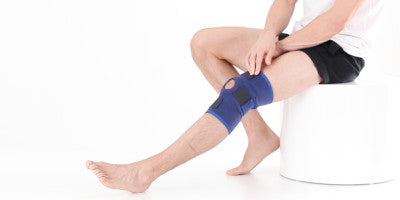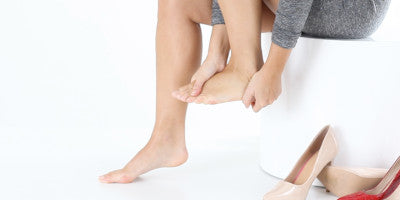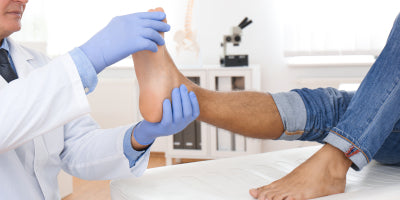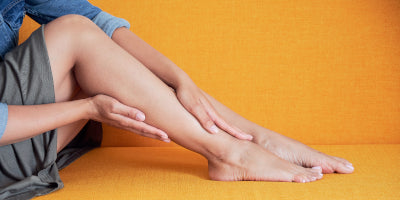How to manage Ehlers-Danlos Syndrome (EDS) and Hypermobility Spectrum Disorder (HSD)

May is Ehlers-Danlos Syndrome (EDS) and Hypermobility Spectrum Disorder (HSD) awareness month. For those who suffer from these conditions, getting a diagnosis can be a challenge and take a long time due to poor awareness. At Neo G, we strive to highlight and make people aware about a variety of different conditions and how we as medical device manufacturers can help to support these individuals.
What is Ehlers-Danlos Syndrome (EDS) and Hypermobility Spectrum Disorder (HSD)?
EDS is defined as a group of 13 heritable connective tissue disorders caused by a genetic change.[1] This change can make the connective tissue weaker and affect tissues that provide support to the skin, tendons and internal organs. The faulty gene can be inherited from one or both parents. However, sometimes it is not inherited at all and for these individuals it is even more difficult to get a diagnosis.
Each of the 13 syndromes have different prevalence’s and distinguishing features with Hypermobile EDS accounting for around 90% of all EDS cases and approximately 1 in 3,100-5000 people [1]
There are some features seen across all 13 types which include joint hypermobility, stretchy skin and fragile skin.
Although there are 13 different disorders, some people will have hypermobility issues but not have any of the specific EDS conditions. For these individuals, they are likely to be diagnosed with HSD and they will be treated in the same way as those with Hypermobile EDS. Along with joint hypermobility, individuals may also have pain, instability and fatigue. It is worth noting that individuals can have hypermobility and not be diagnosed with HSD if the hypermobility is not causing any issues or pain. HSD will be diagnosed when the condition is disrupting the individuals normal physical and mental functions.
Similar to ESD, HSD has 4 different types and these are defined by the location of the hypermobility eg: Generalised HSD is throughout the body whereas Peripheral HSD is located in the hands and/or feet.
How is EDS diagnosed?
An article by Malfait et al [2] highlighted several diagnostic criteria for each of the 13 disorders. If an individual meets these criteria, a genetic test should be done to confirm the diagnosis as most of the disorders are linked to a specific gene. Unfortunately for Hypermobile EDS, a genetic cause has not been identified. Currently, a diagnosis can only come from meeting the clinical diagnosis criteria for EDS.
What exercises can be done for EDS & HSD?
There can be debate on what exercises, or types of exercise, can be undertaken by those with EDS or HSD. When first undertaking any new form of exercise, we would recommend checking that it is suitable for your individual condition. We would also recommend undertaking exercise with a trained professional present, to ensure correct form and that excessive stress is not placed on the joints. Strength exercises can be undertaken using just your body weight and it is recommend these include the following movement patterns:
- Squat/Hip hinge exercises
- Pushing exercises
- Pulling exercises
- Carrying exercises both bilateral and unilateral
These exercises can be progressed over time, depending on the individual. The important point to keep in mind is being aware of your body position during the exercises. Your joints should not be in positions of excessive strain for prolonged periods.
As well as strength-based exercises, Pilates can be beneficial for some users. Many Pilates sessions are run by physiotherapists. This helps you ensure the correct movements are happening, especially in smaller muscles that are key for the stability of the joints. As you are able to do Pilates in a class environment then the social interaction with others can be hugely beneficial for your mental health.
Are supports beneficial?
Supports can be beneficial for individuals, providing they are used correctly and for their intended purpose. Neoprene and elasticated supports can be used to help with proprioceptive feedback as well as providing compression to swollen joints. These types of supports, at their basic level, will not include any stabilizing features, such as splints. Therefore, although an individual with EDS or HSD will be more aware of their limbs’ mobility, the support will not stop them from putting the joints in stressed positions.
The second category of supports that can be beneficial are splinted supports. These could be made from neoprene with metal splints or just a splint on its own. The idea of these supports is to limit movement in the joints either in one direction or completely, immobilizing the joint.
An area that can benefit from a splint are the fingers, as they are a common area that can have dislocations or instability in them. Our Easy-Fit Finger splint has been designed in 4 lengths to either completely immobilize all the joints in the finger or just one of the joints. The flexible shell can also be moulded around the finger easily, allowing you to continue to use the support even if swelling is an issue at times.
Living with Hypermobility Spectrum Disorder
To help us with our understanding of HSD, Kellie from our Customer Service Department, who suffers from the condition, has kindly taken some time to sit down with our in-house Physiotherapist, Alex. They discussed how HSD impacts her in everyday life.
Alex: How long have you had HSD?
Kellie: I’ve had HSD since I was born, as it’s a genetic condition affecting the collagen in my joints, making it too loose and allowing the joints to move too far. I was diagnosed with HSD (then just referred to as being ‘double-jointed’) at 11, when I noticed that my elbows kept locking into position and I had to make them ‘crack’ to get them moving again. This was always accompanied by sharp pain in the joint and I still experience this. Since then, it’s become more apparent that most, if not all, of my joints are affected and can suffer subluxations – partial dislocations – for pretty much no reason. I can set off to walk and my leg will give way underneath me because my ankle or knee has hyperextended and can’t support my body weight.
Alex: How does it affect your day to day life?
Kellie: I must be extra conscious of my joints, making sure I don’t inadvertently hyperextend them. I tend to sit with one leg caught up underneath me and if I sit in just the wrong position, with my weight on my ankle bone, I can cause it to move and then I need to snap it back into place, which can be painful. I also can’t do things like lifting heavy objects too often, as this can mean dislocating my wrists, elbows, or shoulders if I do it wrong. I once tried to go bowling with my team and ended up needing to wear a wrist support to try and stop my wrist popping out when I threw the ball.
I fidget quite a bit because sitting in the same position for too long can become uncomfortable as my body weight presses down on my hips. I often end up hobbling slightly when I get up to walk until my hip shifts back to where it should be.
Handwriting can be difficult because holding a pen results in my index finger joint hyperextending and becoming painful. I tend to tuck my thumb under it to stop it, because I often prefer to handwrite to start with, or use a ring splint to keep the joint where it should be.
I sometimes have seemingly random pain in my joints, my knees especially, and it can feel like a red-hot knitting needle being shoved through it. When this happens there’s not much I can do besides use some heat to try and take the ache off.
When I have particularly bad flares, I do use a walking stick, just for a little stability. Touch wood I’ve not needed to for a while, but it lives in the car just in case.
I have a reputation for being incredibly clumsy because of my HSD and I often find random bruises on my legs from where I’ve unwittingly bashed into a table or some such. I can topple over in bare feet, just because I’ve tried to lift my foot and it’s given way.
Alex: Are the effects just physical?
Kellie: Not by a long stretch! HSD can affect your mental health and immune system. I have anxiety and depression which are exacerbated by the HSD. I also tire out easily and don’t have the best sleep schedule. Mental fatigue can happen much faster than physical tiredness and I can easily get overwhelmed when it happens.
I also suffer with IBS, connected with the HSD, and find that when I have an IBS flare, I tend to have an HSD flare and become really uncomfortable.
Alex: How do you manage the condition?
Kellie: HSD is not a condition that can be cured or made to go away. Because it’s genetic I will always have it. Management is much more protecting the already lax joints and ensuring that you don’t do anything to hyperextend them. I have a few adaptations on my desk that help me, including an ergonomic split keyboard, an ergonomic mouse, and a good, supportive chair. I also have an adaptable footrest, that allows me to keep my legs in a comfortable position and my desk is set up so that everything I need is within an easy reaching distance. Management can be exhausting, because you constantly need to be aware of where your joints are – not easy to do as HSD affects my proprioception, which means I am sometimes unaware of the position of my joints without looking at them. You can often hear me muttering things like ‘soft knees’ to myself because I tend to lock my knees out backwards when I’m standing. I’m told it looks very strange but to me it’s normal. I sometimes use supports to apply compression to the joints when they are in the burning pain stage, and sometimes, if I’m going to be doing something out of the normal, such as a particularly long walk or moving house, I’ll use a support for my ankles or back to protect them. It can be pretty miserable in the winter as my fingers ache when they get too cold, partly due to an old injury on one of them, but also due to the HSD. I use a pair of arthritis gloves to support them when this happens, and my friend knitted me a pair of themed fingerless gloves to go over the top of them.HSD is an invisible condition, because to outward appearances I look absolutely fine, but I can have days where I just can’t function properly through either pain or fatigue. I am a stubborn person and I tend to just push on through, then have a nice hot bath at the end of the day.
Alex: What do you wish others knew about the condition?
Kellie: That, whilst it doesn’t sound like something very serious, it can have a debilitating effect on a sufferer’s daily life. Everything takes extra effort to be conscious of not overextending yourself and sometimes you wake up and have no physical energy for the day. It can be frustrating when your mind says you can do something, but your body disagrees. We often need just a little bit of kindness and understanding to get through the day.
We'd like to thank Kellie for being so open and speaking to us about her personal experience with Hypermobility Spectrum Disorder. We'd also like to thank her for her continued excellent work in our Customer Service department!
References
[1] https://www.ehlers-danlos.com/what-is-eds/
[2] MalfaitF,et al.2017. The2017internationalclassificationoftheEhlers–Danlossyndromes.AmJMedGenetPartCSemin MedGenet175C:8–26.










